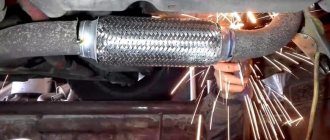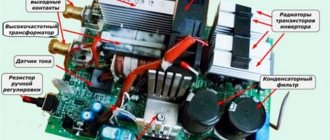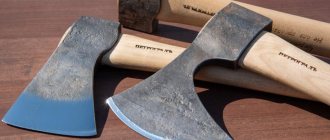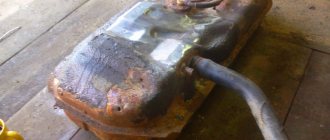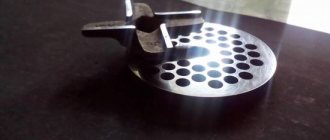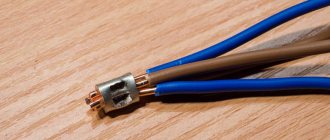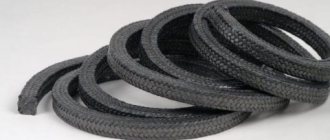If you decide to start painting your vehicle, it is likely that you will be faced with through holes in the body that have arisen as a result of exposure to rust. It is worth noting that body repairs are quite expensive, so not every car enthusiast wants to turn to professionals.
As a result, many are interested in how to repair holes in a car body without welding with their own hands. This is exactly what we will talk about now.
How to repair through holes on a car body using putty without welding
Before repairing a hole in the car body, you should prepare:
- fiberglass and automotive putty;
- aluminum mesh;
- putty knife;
- sandpaper (if possible, it’s also worth looking for a sanding machine);
- primer, paint, varnish.
Fixing holes in a car body itself is distinguished by its simplicity. First of all, you should remove the rust using an angle grinder or any other suitable equipment. Next, we cut out the patch from aluminum, and then attach it to the body using masking tape. We apply a thin layer of fiberglass putty (here it is important not to touch the tape, because then you will have to remove it). When the putty sticks, peel off the tape and putty the remaining areas.
It is important that the layer is as thin as possible, without tubercles or other irregularities.
When everything is dry, sand everything using coarse sandpaper or a sander.
Having achieved a flat and smooth surface, apply a second ball of putty - automotive putty. We wait until it dries and level it again. Then the surface is primed (do not forget to cover the areas that do not require painting with film). When the primer is finished, you can paint the body.
It is worth noting that the patch will be more stable if you apply a couple of layers of putty on the back side. In addition, it is also possible to seal holes in the car body without welding using putty and without using a patch. In this case, it is necessary to apply a lining on the back side so that the composition is well fixed. On the other hand, this solution is only suitable for very small through holes.
Let's watch a detailed video on how to seal holes without welding:
Restoration of permanent thresholds
A reliable technology for restoring a permanent threshold remains the application of a metal patch by welding if there are through holes and large corrosion damage. Pull out dents with a reverse hammer or spot welding; chipped paintwork with epoxy resin.
If it is necessary to repair a removable part from primary rust and it is not possible to replace the part, it is recommended to use fiberglass and epoxy glue.
The thresholds are first removed so as not to damage other body parts. Then traces of rust are removed from the surface using a solution. Next, the epoxy resin is diluted with a hardener and applied to a previously degreased surface. Pieces of fiberglass of the required size are placed on the laid glue and pressed down for adhesion. After 12 hours, the area is sanded, uneven areas are removed, a layer of primer is applied, and at the final stage it is painted.
If we are talking about minor damage - rust or dents in a small area, then even beginners can do such repairs. If you lack the skills or desire, it is recommended to contact specialized workshops; tinsmiths will conduct a full inspection of the part and adjacent elements, and will also suggest how to seal the thresholds in the car reliably and quickly.
Using a soldering iron
There is another way to repair a hole in a car body without welding. A soldering iron is required here. First of all, we clean the area from rust. We make the patch from a sheet of metal (you don’t need to worry too much about this; an ordinary can of auto chemicals will do).
It is important that the patch is slightly larger than the holes and also completely covers them.
Additionally, you can coat the metal surface with anti-corrosion compounds - this will increase the quality of our repairs. Then we service the edges of the patch, after which, using a fairly powerful soldering iron, we solder it with a continuous seam.
Next, you should check whether it turns out that the patch protrudes somewhat above the body. If there is a protrusion, we eliminate this deformation with several gentle blows of the hammer. We remove various dents with putty (it is important that its layer reaches no more than 2-3 mm, otherwise the material will crack). Before filling, clean the surface with a metal brush.
In order for the putty to adhere well, it is important that abrasive marks (small scratches) appear on the patch.
The next step is primer. Here it is necessary to complete everything as quickly as possible to avoid the possibility of rust occurring in the future. It is best to first apply a thin layer of phosphate primer, and when it dries, another two or three layers of acrylic two-component composition (the interval between applications should be about 5-10 minutes). Everything dries in about 3-4 hours; if there is infrared heating, you can reduce the procedure to 20 minutes.
It is worth noting that this solution is more durable than in the case of aluminum mesh, and it can be used to eliminate holes of almost any size.
So, in the article we discussed how to repair holes in a car body without welding. It is worth noting that these options are not the most optimal. Naturally, it is better to turn to professional vehicle repair specialists. At the same time, self-repair will help give the body an aesthetically attractive appearance and also prevent further development of corrosion. Both options are distinguished by their simplicity, so repairs can be performed even without special knowledge and skills.
Repairing large-scale damage
Any hole in the threshold of a car indicates the beginning of corrosion, but what to do if the destruction of the metal is large-scale and simple means cannot be avoided? In this case, a gas welding machine is required, a complete digestion of the body, and sometimes a complete replacement of parts of the bottom and wings.
Superficial repairs using putty, fiberglass, and small metal patches will not change the situation dramatically; rotting of the body will continue.
Thresholds and bumpers are considered the most vulnerable parts of a car body. Gravel flying out from under the wheels of the vehicle in front damages the paintwork, and improper crossing of the edge and careless parking lead to dents. Timely repair of thresholds without welding with your own hands will prevent corrosion of the metal and seal and restore the aesthetics of the car.
Filling holes in the body with putty
As a rule, holes most often appear on the bottom of the car. And in this case, everything around is thoroughly cleaned, car cosmetics (rust converter) and many other kits are used. Degreasing and priming are also required.
The technology of direct application of putty, without the use of a patch, involves application from the back side of the lining area. In this way, it will be possible to significantly achieve maximum fixation of the composition. You can use a metal mesh instead of a lining as such. These are even sold in stores, you can make them yourself, etc.
The putty must be evenly distributed over the surface, filling the entire space of the hole. After the solution has dried, the area is treated with painting putty. Then, after drying, they paint and put on a protective film.
This option for eliminating a through hole in the body is the simplest. Experts, however, do not recommend using it, since the putty will begin to leak moisture over time and will collapse. This method is most suitable if restoration is urgently needed and there are no other alternatives.
What defects may there be?
The procedure and specifics of work when restoring car thresholds depends not only on their type, but also on the damage received.
Damage that can be repaired without welding:
- shallow dents without sharp edges;
- chips of paint coatings due to small pockets of corrosion;
- pinholes caused by corrosion.
Rotten metal thresholds can only be repaired by welding. It is advisable to repair removable elements only in case of minor damage, which can be easily repaired on your own. If the defects are significant, it is better to replace the removable spare part with a new one, since the price of analogues and the cost of repair work are almost equal.
Algorithm for carrying out the process of eliminating a through hole by applying a patch with a soldering iron
Here's what to do:
- To begin with, it is recommended to thoroughly clean the rust from the corrosive area. You can use attachments and a drill (also another set of tools).
- A patch is cut from a piece of metal sheet. An option is to use a can of auto chemicals, etc.
The patch must cover the entire hole on the vehicle frame element.
- A powerful soldering iron is prepared, with which the patch is applied.
It is also recommended to use anti-rust compounds, otherwise called orthophoric acid. Another help will be the use of tin solder.
- Now you need to tin the edges of the patch.
Particular attention is paid to the edges of the hole where the patch will be placed.
- A piece of metal is soldered with a continuous seam.
- It is checked by measuring whether the patch does not protrude above the surface of the body like a bubble.
You can diagnose the protrusion using a flexible ruler.
- The protrusion (if detected) is recessed with gentle blows of the hammer.
Once the patch is recessed, there is bound to be a small gap. It will need to be leveled using putty. We must not forget that the thickness of the putty layer should not exceed 2-3 mm. Otherwise, the layer will crack easily after drying.
- Before puttying, the surfaces are properly prepared: the rust is cleaned off with a metal brush, and then sanded.
It is better to use 120-grit sandpaper. We must not forget that the matting area should be larger than the area directly being puttied.
- An abrasive mark is applied to the surface. This is done so that the putty has something to hold on to.
- Now you need to treat all areas with a degreaser after sanding.
- The surfaces must be primed first. This is done no later than an hour after sanding, since cleaned metal without paintwork quickly undergoes oxidation processes.
It is better to take a phosphate primer as the first layer. This type of primer is a 2-component composition that is easily diluted with water.
Attention. It is prohibited to dilute phosphate primer in a metal container. The fact is that phosphate tends to interact with iron, and this is not good. It is better to use a glass or plastic container.
If you can’t find a phosphate primer, aerosol KSL primer in cans is also an option.
Leveling out dents on a removable threshold
How to make daytime running lights with your own hands
Repairing damage to a removable threshold is much easier. For this type of work you will need:
- a workbench or flat base plate on which straightening will be done;
- set of tools for straightening. It includes all kinds of hammers (soft and hard), planes and chisels for straightening;
- grinder and welding machine or pneumatic chisel.
To level out a dent on a car's removable threshold, proceed as follows:
- disconnect the damaged part of the car. To do this, you just need to screw in all the fastening bolts that held it in place and carefully pull out the part;
- install the damaged threshold on the workbench;
- using hammers and other tools for straightening metal products, carefully bend all the irregularities in the opposite direction;
- treat the entire threshold with a good anti-corrosion agent;
- put the car sill in place.
It’s worth remembering that this method of pulling out dents on a car’s removable threshold is not universal. It is relevant only in cases where the threshold is not too damaged and can be returned to its original state with hammer blows.
However, if the dent cannot be repaired, or if rust has already affected it, it is better to throw away such a part and put another one in its place. The advantage of this method of leveling dents is that there is no need to paint the damaged fragment - it will retain its original color.
Other solutions
Recently, it has been possible to close the holes in other ways. One of them involves working with fiberglass.
- The surface of the body is also cleaned and degreased, as in the two cases described above.
- Overlays are cut out of fiberglass, the size of which should be 2 cm larger than the hole size.
- The area is pre-primed and the composition is given time to harden.
- The pad is applied to a completely dry surface.
- Fiberglass linings are fixed using an adhesive-resin composition.
First, one overlay is glued, then the second, third, and so on. Again, it is recommended to put a lining on the reverse side.
After the glue has dried, the body surface is treated and painted.
As you can see, holes on the car body caused by corrosion can be easily eliminated with your own hands. Visual examples can be seen in the video and photo.
Forget about fines from cameras! An absolutely legal new product - Traffic Police Camera Jammer, hides your license plates from the cameras that are installed in all cities. More details at the link.
- Absolutely legal (Article 12.2);
- Hides from photo and video recording;
- Suitable for all cars;
- Works through the cigarette lighter connector;
- Does not cause interference to radios and cell phones.
The first manifestations of through body corrosion in cars of the domestic automobile industry appear already in the second year of operation. In this case, it is not necessary to contact a car repair shop, since repairing holes in the car body without welding is quite simple. Craftsmen have come up with several ways to quickly patch small holes, such as arches or holes in the wing. However, methods without welding are unacceptable for repairing power elements.
Cold methods of sealing holes in metal
There are two ways to repair holes in the underbody of a car without using hot work.
- Using composite materials - various types of polymer resins in combination with a reinforcing filler and a curing reaction accelerator. With high-quality surface treatment, in addition to restoring mechanical strength, they play the role of inhibitors - retarders of chemical and electrochemical corrosion reactions;
- Installing sheet material patches onto rivets.
General technological rules
Holes in the bottom are usually discovered from the outside, when inspecting the car on a pit or lift. Signs of through corrosion are local swellings, which, when you try to pick them out, crumble into dust.
If you find such troubles, you need to open and remove the pie of heat, noise and waterproofing on the floor in the cabin in the entire area where the sheet of iron forming the floor is welded to the power elements of the body - thresholds, tunnel and others. Then you will see the whole picture of the damage and will be able to take preventive measures in those places where corrosion has not yet become through.
Body repair with putty
This method is used when you urgently need to repair a small hole without welding or there are no other options for car repair. However, it should be understood that this is a temporary measure, since the putty will quickly crumble. To repair the damage, use a special putty with small, medium, and large glass fibers. When preparing it, you need to ensure that there are no air bubbles. To create an even layer, a lining is installed on the back of the hole.
A primer is applied to the prepared area of damage. After it dries, putty with large fibers is applied. Depending on the size of the hole, several layers are applied and each layer is completely dry. The total thickness should not exceed 2 mm, otherwise the patch will begin to crack. The last layer is applied with fine fiber putty. The repaired surface of the car is treated with fine-grained sandpaper.
Repair of removable structures
Removable thresholds are easy to disassemble and replace. They are convenient and practical to use. They are installed outside or on the side on the side members. Removable sills provide effective stone protection for the underside of the machine.
To repair removable elements, use metal or plastic. Self-healing is performed according to the following algorithm:
- Tighten the fastener.
- Remove the threshold.
- Removing traces of corrosion.
- Putty, application of primer.
- Drawing.
After repair, the parts are mounted from below. If the structure has significant damage, it is completely replaced with a new analogue.
Fiberglass and mesh
To repair more extensive damage, an aluminum patch mesh is used. A piece slightly larger than the hole is cut out of it and attached with masking tape. Next, sealing holes in the car body without welding is carried out in the following sequence:
- a thin layer of fiberglass putty is applied without touching the tape;
- after drying, the tape is removed;
- subsequent layers of putty are applied after the previous one has dried;
- the surface of the car is treated with sandpaper or a grinding machine until smooth;
- To strengthen the mesh, several layers of putty are applied to the back of the body.
Long-term auto patches are made from fiberglass and epoxy resin. Several overlays are cut from it, the first of which should cover the hole with a margin of 2 cm. The size of each subsequent piece is made larger than the previous one. The last overlay should cover all the metal stripped during the preparation process.
How to stretch a threshold without welding
Repairing a threshold after a dent involves using a reverse hammer, a suction cup, or cutting the area of deformation for a non-removable element. The algorithm of action is as follows: it is necessary to drill holes with a diameter of 1-2 mm near the dent, insert special metal corner hooks of a reverse hammer into them. Then tapping on yourself straightens the area of deformation.
You can weld by spot welding, placing the end of a hammer on the dent, and drawing out the metal. In this case, you need to start from the corner of the dent, welding the end every 3-5 mm, while straightening the surface with a hammer.
The most reliable way to stretch the threshold without full welding is to use a spotter, rings, or stop. The method is often used at service stations, since many drivers do not have the necessary tools in the garage. You can make the device yourself from a used microwave oven. Drawing process step by step:
- The negative terminal from the battery is disconnected.
- Using a sanding machine, a layer of old paint is removed from the entire surface of the dent.
- Spot welding is used to install rings through which the puller bar is passed, and the metal is drawn out using a stop. The procedure is repeated until the surface becomes as smooth as possible.
- The metal is sanded with emery, treated with a degreaser, and primed.
- A thin layer of automotive putty is applied and treated with anticorrosive.
- After complete drying, it is painted with enamel.
Another way is to use a vacuum suction cup. This approach allows you to preserve the paintwork. The difficulty of using suction cups is due to the uneven edge of the dent; it is quite difficult to use a vacuum even if the dent has sharp edges and metal creases.
A frequent question about how to repair rotten sills on a car has only one answer: nothing. Rotten parts must be knocked out or cut out, the seal checked, and new metal welded. Cosmetic repairs are used only before urgently selling a car, but this is just one way of deceiving a gullible driver; it has nothing to do with a full restoration.
It must be remembered that thresholds are called rotten if metal corrosion exceeds 65-70% and there are through holes.
With minimal foci of primary corrosion, the elements are ground, treated with putty, and primed. To strengthen the structure, plastic or aluminum overlays are used.
Car body soldering
This method is used to seal small and large holes without welding. To work, you will need flux, which will protect the metal from rapid oxidation. Soldering acid, sold in radio stores, can successfully cope with this task. To achieve the required temperature, you will need a soldering iron with a power of 1 kW or more, or a version heated with a blowtorch, but it is better to use a gas torch. The solder is chosen to be refractory, since it can be used to repair a hole in the car body more reliably.
Small holes are simply filled with solder, starting from the edges and gradually fusing to the center. A large hole in the body is covered with a patch cut from tin from a tin can. It provides:
- strong connection, almost like welding;
- significantly longer service life than putty, but less than welding;
- possibility of sealing large holes;
- ease of implementation, repairs are accessible even to beginners.
The work is performed in the following sequence:
- A patch is cut to fit the size of the hole. The larger the area of contact with the body, the more reliable the connection.
- The soldered edges of the patch and the damaged areas are cleaned with sandpaper until shiny.
- Using flux and solder, the cleaned surfaces are tinned.
- After applying the patch to the repaired area of the car, it is heated to the melting temperature of the solder. In this case, you need to ensure the continuity of the seam so that there are no missing sections.
- After cooling, the remaining flux is removed, and the soldering area is washed with hot water and soda.
The disadvantage of this method is that the patch swells due to heating. If checking with a ruler confirms this, the bubble is removed with light blows of a hammer.
The resulting depression is leveled with putty:
- Marks are applied to the surface of the patch, plus a few millimeters from each edge, with 120-grit sandpaper. This is necessary for reliable adhesion of the putty to the metal.
- The cleaned surface is cleaned of dust and degreased with a solvent.
- To prevent the metal from becoming rusty, the primer is applied no later than an hour after preparation.
- The first 2 layers are applied with a phosphate or acid primer with an interval of 15 minutes.
- After waiting another quarter of an hour, apply 2 - 3 layers of acrylic primer at intervals of 5 minutes.
- It takes 3 - 4 hours to dry completely. The drying process can be accelerated using an infrared heater.
Is it worth soldering
You can also seal holes in the bottom using soldering. However, ordinary household soldering irons are not suitable for heating metal with a thickness of 0.5 mm or more. Most likely, a hair dryer will not help you with this. You need to use a portable gas burner, for example, Super-Ego R355, which fits into a small - volume from 400 to 700 ml - cylinder for camping stoves.
Solder and flux are required for soldering. The solder used is low-melting, with a predominant content of tin or lead. Flux can be replaced with electrolytic acid. The connection is strong and can withstand high vibration loads.
Soldering has two disadvantages.
- It involves hot work, which increases the overall complexity of the repair. This can be neglected if your hands grow from the right place;
- The main material of solder - lead or tin - is a substance that has a lower electronegative potential than iron. Therefore, upon their contact, electrochemical corrosion occurs, in which iron will play the role of a “sacrificial anode” and be destroyed.
Now you have an idea of how to seal the underbody of a car without welding. If you are careful and persistent in cleaning the surfaces, then treating them and protecting them, then the installed patch can outlive the car itself.
Rivets
This method not only repairs large holes in the car body, but also replaces parts (fenders, aprons) without welding. In terms of reliability, it is not inferior to welding. It is recommended to install rivets in an inconspicuous place. Since there is no splash of molten metal during operation, like welding, it is often used to repair car floors.
The riveter required for the job can be bought in a store (costs approximately 500 rubles). The technology is simple:
- The patch is cut so that it overlaps 2 cm around the edges of the hole.
- By attaching it to the body, it is given the desired shape.
- The locations of the holes for the rivets are marked.
- After drilling the patch with a drill according to the diameter of the rivets (4 - 6 mm), it is advisable to countersink the edges of the holes so that it fits more tightly to the surface of the car body.
- Having applied the patch again, the center of the first hole is marked and drilled.
- After riveting it and leveling it, the patches are tapped and the remaining holes are drilled in place.
- To ensure a tight fit of the patch to the car body, rivets are fastened from the center to the edges.
- To prevent moisture from getting inside, the joint around the perimeter and rivets is coated with sealant.
Car threshold repair
Let’s immediately talk about removable thresholds; their service life is shorter than others. Therefore, they can be replaced simply and quickly. Thresholds with mechanical damage or when they are completely worn out need to be replaced.
Dents on the thresholds can be smoothed out. To do this, you need to remove the sills by unscrewing all the bolts that attach them to the body. Advice: in order not to disturb the shape of the body, place some supports under it.
In case of partial damage, it is not necessary to change the thresholds. To restore them, putty is used, after which the thresholds are painted and installed back on the car. This will save you money.
Final stage
Regardless of how the car body was repaired, they all end with putty. However, it absorbs moisture, which leads to rapid destruction. Therefore, it must be coated on top with an anti-corrosion or epoxy primer. Body repairs are completed without welding by painting. To do this, use a spray gun or aerosol cans, after covering the adjacent surface of the car with plastic film. You should not use a brush, as drips are possible.
The proposed methods will help to repair a car without welding in case of single damage. However, if a large area is affected by corrosion, it will be easier and more reliable to contact a car repair shop to replace the rusted area by welding. Most often this happens to the floor, so it is recommended to regularly check it from underneath the car using an inspection hole or lift.
What does “cold welding” consist of?
Technical pastes consisting of epoxy resins, hardeners and plastic fillers are called “cold welding,” but this is a conventional name.
Most formulations include:
- resin - a synthetic mixture. Different manufacturers develop their own unique compounds;
- hardener - a substance due to which the paste gains the ability to harden. The chemical formula also depends on the brand of “cold welding”;
- filler - a composition that gives the mixture greater viscosity. This is necessary for ease of work, since the epoxy resin itself is very fluid.
The role of filler can be played by small shavings of steel, aluminum or synthetic substances.
The quality of “cold” welding depends on the specific manufacturer; before use, it is important to study for what purposes it was developed, the conditions for its proper storage, expiration date and rules of use. If the recipe is broken, or Cold Welding has been in use for too long, then a reliable connection will not be achieved.
Almost any paste that can completely adhere to steel and turn into a solid substance is suitable for repairing a car body.
Types of car thresholds
Before you begin repairing the threshold, you need to clearly understand what you are faced with and what leveling method you will need to use. This directly depends on the type of part installed on your car. All car thresholds can be divided into two main categories:
- Removable. Such a part can be easily removed at any time, because it is attached to the body and bottom using ordinary bolts.
- Cast. They are welded to the vehicle body at the factory and cannot be removed. Such a threshold can only be removed by cutting it out. So repairs are usually carried out without separating the part from the car.

